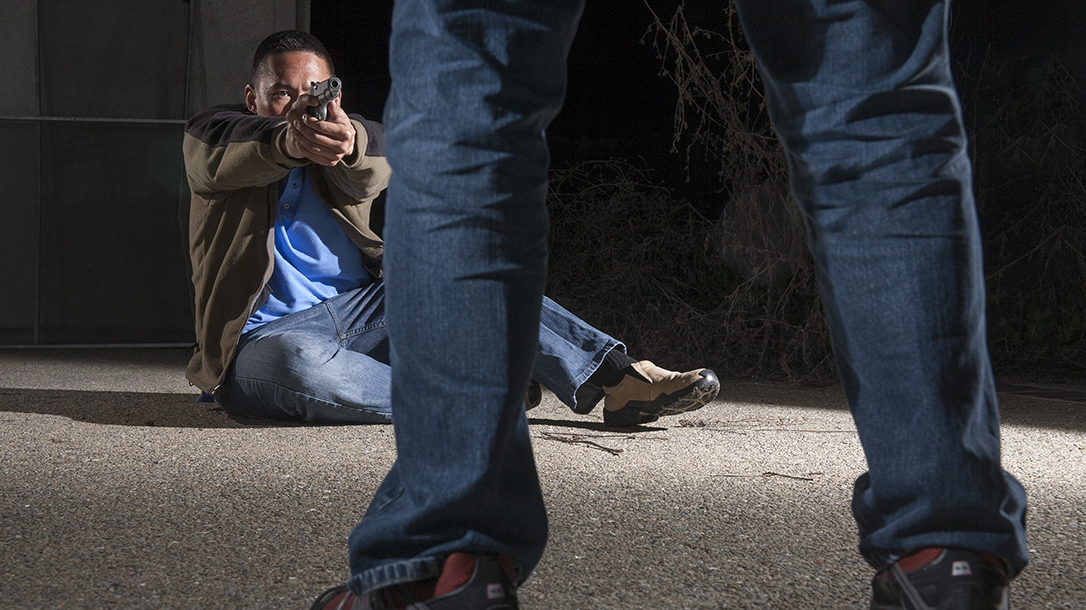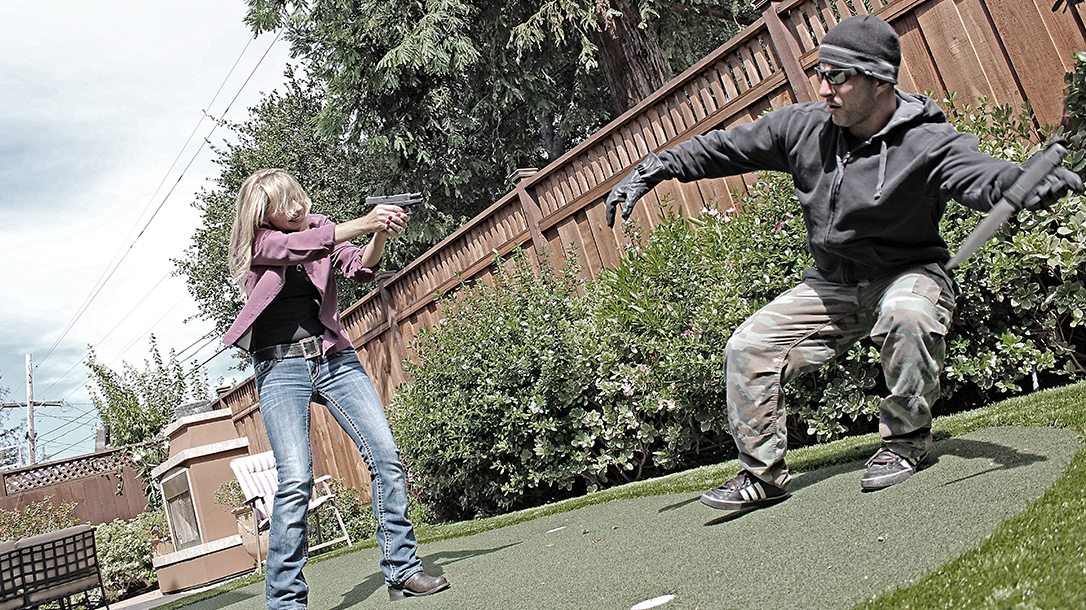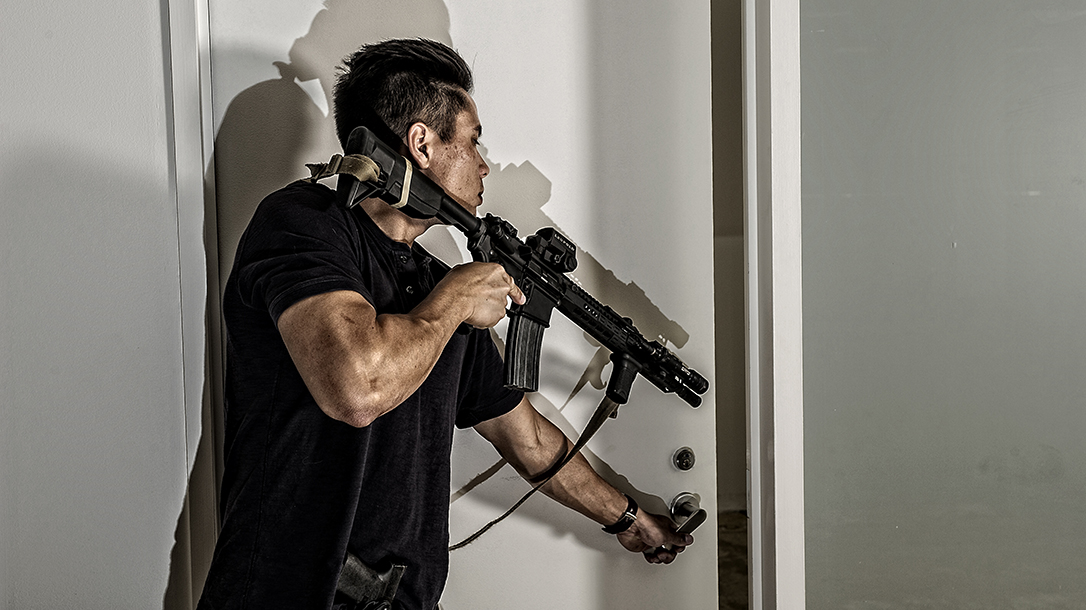Have you ever given the self defense laws and your state a review? Put yourself in the following scenario.
A mother is home at night and starts the bedtime ritual of tucking in her children. The house is quiet and the children are finally falling off the sleep. The mother begins to relax and think about what else she needs to attend to in the home, then she hears a noise.
Advertisement — Continue Reading Below
What was that? Was it outside? A tree branch, car, glass? Questions begin to swirl in the mothers mind and automatically the “Are we safe?” light starts begins to blink red. She thinks of herself and the almost asleep children. A noise echoes through the house again and the mother’s instincts red line — she senses a threat.
She runs to her bedroom and opens the bedside safe and draws the pistol she has taken a few lessons with. Now what? Does she stay upstairs? Does she go downstairs?
As she moves into a protective position between the stairwell and the children’s rooms, she points the weapon and thinks, “Can I shoot? Should I shoot? If I do shoot, when and what will the police think?”
Advertisement — Continue Reading Below
The mother pulls out her cell phone and calls 9-1-1. The operator answers. The mother gives the location and then pauses and says, “I think someone is in my house.” The operator dispatches the police, but will they arrive in time? Seconds tick by and the mother hears the muffled sounds of movement from downstairs.
Her hand tightens on the pistol and it begins to shake. She takes a deep breath, remembering her shooting lessons, and then calms some She sees what looks like a shadow on the stairs and starts to move her finger to the trigger.
Pulse racing and breathing quiet but heavy, the shadow continues to grow until …
Advertisement — Continue Reading Below
Whether to Protect and Defend
With more than 270 million civilian firearms in the United States, according to AmericanGunFacts.com, more and more Americans are learning how to protect themselves.
Americans, especially women, tend to be more inclined these days to ensure that they not only have the ability to defend themselves, but also the knowhow.
According to a National Institute of Justice report entitled, “The Armed Criminal in America: A Survey of Incarcerated Felons,” when asked, three out of five felons said they wouldn’t mess with an armed potential victim.
Advertisement — Continue Reading Below
More than 200,000 women have reported using a gun to protect against a sexual assault.
All of this points to the realities that when confronted with a crime, those armed with a firearm have a better chance of survival than those who are not.
Self Defense Laws and Rules
Unfortunately, when confronted with these survival situations, many civilians don’t realize or are confused by the myriad of self defense laws, regulations and bad advice they read in the media or find online.
Advertisement — Continue Reading Below
One misnomer is that civilians are guided by a civilian use of force continuum. There is no such thing. Only those in law enforcement and the U.S. military have any type of use of force continuum.
Even with that, a Supreme Court case in 1989 titled “Graham v. Connor” actually opened up law enforcement use of force to a “reasonableness” standard based on a “totality of circumstances.” This means that there was no “continuum” law enforcement had to follow. They could address a threat using whatever force was necessary to compel compliance.
Advertisement — Continue Reading Below
The only reason use of force continuums stayed around for a while was due to the inertia of change within law enforcement. Today, most law enforcement agencies use of force policy mirrors the “Graham v. Connor” decision.
Types of Laws
So where does that leave civilians? With a patchwork of state laws that attempt to provide guidance if faced with a life and death situation. Many states have adopted either “stand your ground,” “duty to retreat” and/or “castle doctrine” that guide civilian self defense.
Let’s start with states that have passed “stand your ground” laws.
Advertisement — Continue Reading Below
An individual in that state has no duty to retreat from the situation before resorting to deadly force. It is also not limited to just your property. This means if you are confronted by a threat on the street that dictates deadly force, that situation is covered by stand your ground laws.
Next on the list is “castle doctrine.”
Almost all states have some form of a castle doctrine since a person’s “home” is generally considered their “castle.” These doctrines generally allow deadly force to be used in any real property, such as your home, yard, or private office. There is no duty to retreat in your “castle.”
Advertisement — Continue Reading Below
Some states, like Missouri and Ohio, even include personal vehicles.
Then there are states like New York, New Jersey and others whose law is structured as a “duty to retreat.”
Duty to retreat means you have to retreat from the situation if you feel threatened. You can only use deadly force as a last resort. However, by the law, are not allowed to use deadly force if you are safely inside your home. So if someone is trespassing on your property and you are “safe,” you can’t use deadly force to protect your property in these states.
Final Thoughts
Although every use of force incident is investigated, it’s highly unlikely that a civilian use of force incident will be held to the same standard as a law enforcement use of force incident. Additionally, while states have attempted to provide some guidance for civilians, most probably recognize a general obligation to protect your life or the life of another.
So when the choice to save your life or the life of another hangs in the balance, know your states self defense laws and level of training.

























